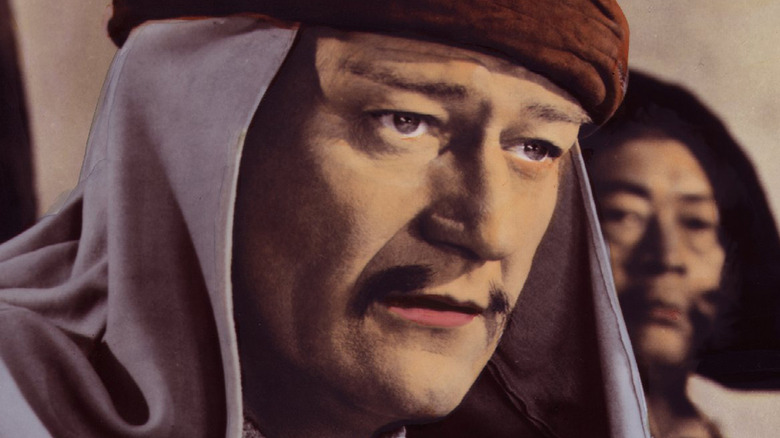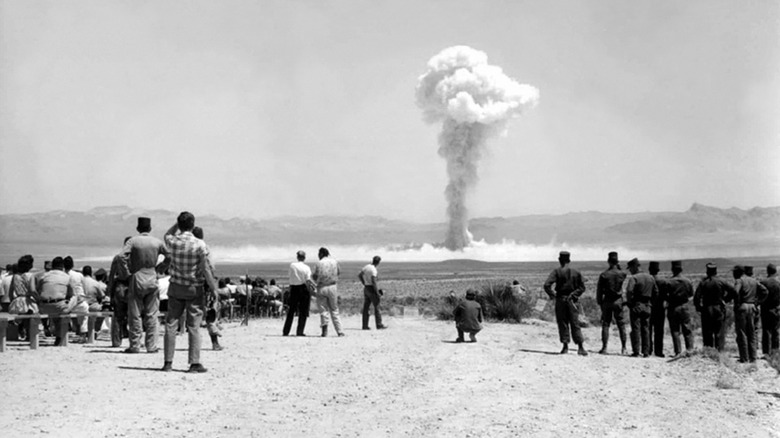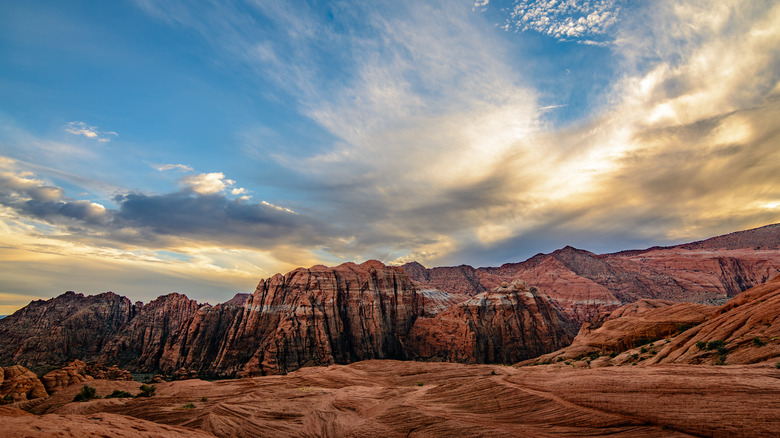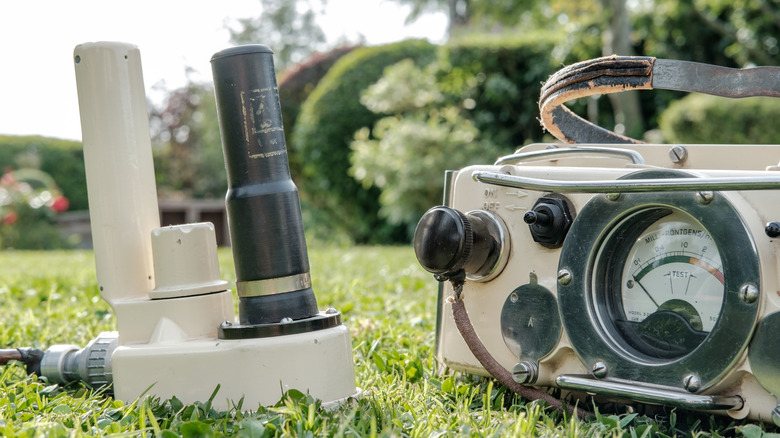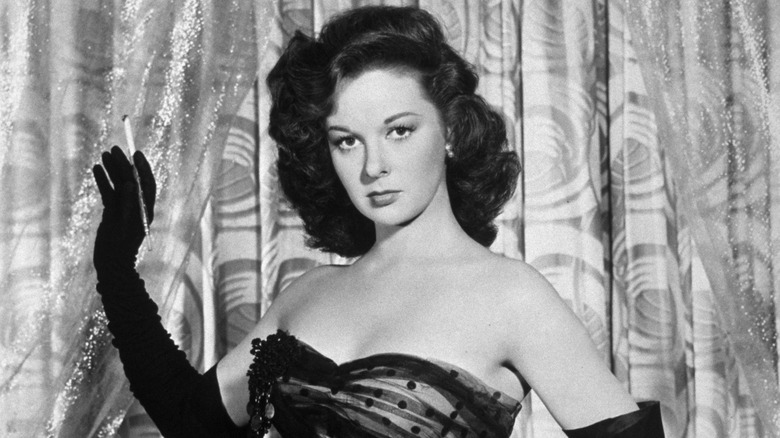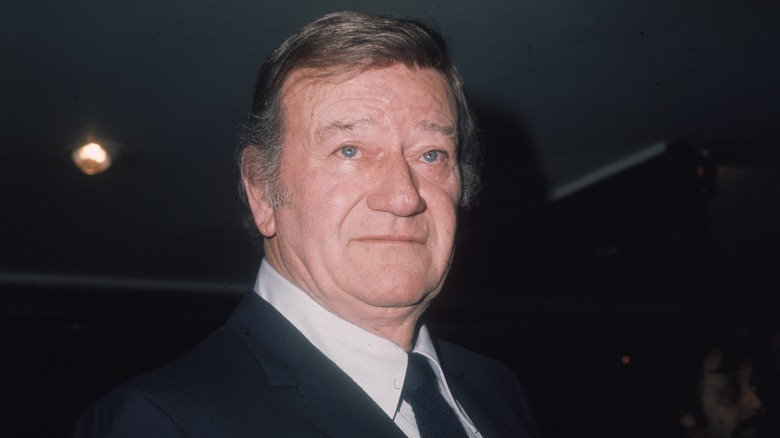A Stunning Number Of The Conqueror's Cast And Crew Developed Cancer
The John Wayne movie "The Conqueror" was released in 1956, and gained notoriety as one of the worst movies ever made, according to The Telegraph. Wayne, famous for his drawl and often cast as a cowboy, was miscast as warlord Genghis Khan of the Mongol empire. He wore a thick layer of yellowface makeup and botched his complicated line readings. The film was an instant bomb. It returned $4 million at the box office after costing $6 million to make, critics made fun of it, and audiences didn't care for the intense scenes of sexual assault and laughable dialogue.
But perhaps the worst part of the movie was the production process. During filming, the cast and crew spent three months in a hot, deadly valley with no idea of the dangers around them.
According to People, the movie was filmed in the summer of 1954. The crew spent that June, July, and August in Saint George, Utah, filming the tale of Genghis Khan and the princess he captures and falls in love with. There was a major issue with the location — besides being the Utah wilderness in the summertime. Worse still, it was just 137 miles from a very active atomic testing range.
Unknown dangers
In 1953, according to People, the federal government tested 11 nuclear bombs, with two that left a large amount of debris containing dangerous isotopes like strontium 90 and cesium 137. As the detritus rained down from the bomb, it tended to be windswept into valleys, like Snow Canyon, Utah, where "The Conqueror" was filmed one year later. So little was known about the dangers of nuclear weapons in the 1950s that in 1957, years after the filming of "The Conqueror," five Air Force officials voluntarily stood under an atomic bomb as it was detonated, with no idea what a death sentence it could be (via NPR).
Radiation can last a long, long time. The United States Environmental Protection Agency reports that radiation can cause heart problems and death, and even in minute doses, it can increase the risk of cancer. Per The Guardian, although local media said the testing was safe, thousands of sheep died on nearby farms in the aftermath of the tests.
Heat and animal attacks
When filming for "The Conqueror" began, the production team, actors, and crew were all unaware of the dangers, according to The Guardian. During the three-month shoot, many of the actors and crew stayed in nearby hotels, ate local cuisine, and spent hours each day filming in the dusty valley.
According to "Killing John Wayne: The Making of the Conqueror," everyone involved would have spent hours each day in these radioactive hot spots, breathing in radioactive sand particles and drinking contaminated water. Per People, the wind blew nonstop, leading director Dick Powell to wear a surgical face mask, since he would repeatedly stumble and fall in the sand. There was no escaping their radiation exposure.
The Telegraph reports that the temperature often soared to 120 degrees. In one scene, Susan Hayward was attacked and nearly bitten by a black panther. And during the first month of filming, a flash flood wiped out multiple set pieces and nearly swept away the cast and crew.
Shipping tons of radioactive sand
A photo circulated of Wayne holding a Geiger counter, used to detect radiation levels, on the set of "The Conqueror" as his sons looked on with concern (per The Guardian). The Geiger counter apparently made such a loud detection noise that Wayne was alarmed, and wondered if it was broken as he moved it around the set. But it was not — the levels of radiation where "The Conqueror" was filmed were so high that dozens of people were harmed.
Even after filming had wrapped, the stars still weren't safe from the radioactive material (via People). The studio ordered 60 tons of sand from the desert to be shipped to Culver City for reshoots of some scenes, exposing their cast and crew to low radiation levels.
Actress Agnes Moorehead was one of the first people who was concerned about the fallout of "The Conqueror" film shoot. She told friends that everyone on the shoot was exposed to radiation — and she tragically died of uterine cancer in 1974 at the age of 73.
The tragic aftermath of the Snow Canyon shoot
Actor Pedro Armendáriz developed kidney cancer after the shoot, and he did beat the disease for a while, according to People. But in 1963, at age 51, he was told that he now had terminal cancer in his lymphatic system, and had about three months to live. He returned from the doctor's visit, and after requesting his wife make him a meal in another room, he killed himself. Actress Susan Hayward developed skin, uterine, and breast cancer, as well as a brain tumor, before dying in 1975 (via People). Later on, according to Turner Classic Movies, her twin sons developed cancer, too — apparently as a result of their visits to "The Conqueror" set.
And as The Telegraph reports, producer Howard Hughes was wracked with guilt over the decision to film in a radioactive valley. Hughes bought every copy of the movie he could find, spending $12 million to do so. He spent his final months watching "The Conqueror" over and over again while holed up in his penthouse hotel room with thousands of copies of the movie. He was reportedly so ashamed of the film that he even insisted that the projectionist wear a blindfold during the showing, so that no one except Hughes would ever view the film again. Hughes died in 1976. As for American film star John Wayne, he was diagnosed with stomach, lung, and throat cancer, and died in 1979 (via People).
The RKO Radioactive Picture
According to Turner Classic Movies, actress Jeanne Gerson developed breast cancer and skin cancer from her time on set, and filed a class-action lawsuit against the United States government in the 1980s.
In total, according to The Telegraph, 91 of the 220 members of "The Conqueror" company were diagnosed with cancer, an astounding 41% of the cast and crew. The Guardian reports that the film gained the ominous nickname of the "RKO Radioactive Picture," as it became increasingly clear what was causing so many deaths.
John Wayne's sons were split over what really caused their father's death (via "Killing John Wayne: The Making of the Conqueror"). His oldest son believed it was Wayne's heavy smoking that caused his cancer, while his other son said that suing the government wouldn't bring Wayne back. People reports that many other family members of "The Conqueror" company had visited the set to spend time with their loved ones, not knowing the immense danger it posed. The children of the cast and crew believe that talking about what happened at Saint George will also raise awareness of the situation of the area's residents, who have also experienced physical harm from radiation. According to The Telegraph, Michael Wayne, one of John's sons who had visited him on set, died of cancer in 2003 at the age of 68, continuing the deadly legacy of "The Conqueror."
